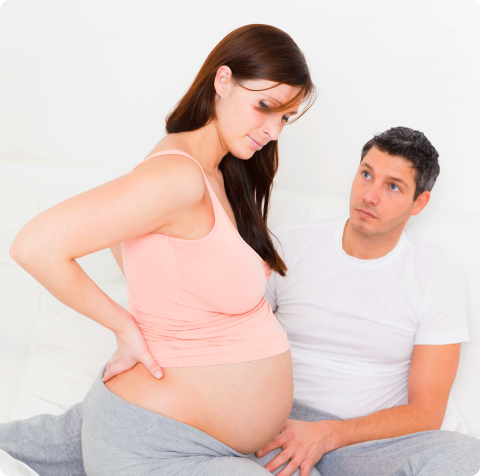Am I in labour?
As the end of your pregnancy approaches, the hormonal balance which has been maintaining your pregnancy shifts. The lower segment of your uterus relaxes and the baby may engage in your pelvis. Increased endorphin levels can lead to a wonderful sense of well-being and really vivid dreams. You might find yourself drawn to practical preparation activities at home, sometimes called 'nesting'. Your uterus will become more sensitive to circulating oxytocin and the Braxton Hicks contractions which have been toning the muscles and providing sensorial stimulation to your baby may become more intense. This is called pre-labour and these tightenings tend to be 60 - 70 seconds long.
You may experience a 'show' as the mucus plug comes away from your cervix and your waters might break ahead of labour. Sometimes as a big gush, or perhaps as a trickle. Your baby's position and application to your cervix can greatly effect the rate at which oxytocin levels rise in your blood stream. As oxytocin levels rise, your contraction pattern will change. Early labour contractions last 30 - 45 seconds and are regular, coming 30 minutes apart and closing.
Engagement
During the final weeks of pregnancy, the baby's head moves down into the pelvis and 'engages', as the muscles of the uterus relax under the influenece of pregnancy hormones. You may experienced 'lightening' giving you more room to breathe. This can happen any time from 36 weeks, but in 50% first time mums, it happens between 38 and 42 weeks. For 80% of first-time mums, labour will begin within 2 weeks of the baby's head engaging.
For women having their second or subsequent baby, the baby might not engage until labour begins.
If the baby engages in your pelvis you can feel confident that the entrance to your pelvis is big enough and the probability is that the space inside your pelvis and the 'outlet' will also be big enough for your baby to pass through.
Nesting
During this time you might experience significant emotional changes as the hormonal balance of your pregnancy shifts. ‘Nesting’ is a definite phenomenon in late pregnancy, so don’t be surprised if an uncontrollable urge to clean the woodwork or wash the baby clothes again takes over!
As part of this late pregnancy hormonal shift, rising endorphin levels increase your pain threshold and sense of well-being. Last minute apprehesion about the birth or anxiety about the baby's wellbeing often dissolve in the final weeks due to this increase in endorphin.
Prelabour ‘Tightenings’
As labour approaches, the balance of oestrogen and progesterone changes and the natural level of prostaglandin increases. This increases the uterus’ sensitivity to the oxytocin circulating in your blood. One effect of oxytocin is that it makes the uterus contract and so the Braxton Hicks contractions or tightenings which have been occuring since 30 weeks, begin to intensify. Oxytocin levels are highest at night when our background adrenaline level drops. This means that in the final weeks of pregnancy you might find the tightenings becoming strongest and most frequent at night, when you are trying to sleep. This period is sometimes called 'Pre-labour'. Being able to catch up on sleep during the day in the final weeks is important. Research has shown that women who have had more sleep in late pregnancy have shorter labours.
The change from the nocturnal pre-labour contraction pattern into early labour, varies from woman to woman and can be influenced by the level of mental activity you are engaged in day to day, your baby’s position and how ready you feel for labour.
Pre-labour or Braxton-Hicks contractions, will be softening and thinning your cervix and working to move your baby into a better position for birth. On the whole, they are not powerful enough to start to open up the cervix. Prelabour or Braxton-Hicks contractions tend to be quite long, around 60 - 70 seconds in length. Early labour contractions will be shorter than these first tightenings, around 35-40 seconds long. The key difference between these pre-labour contractions and early labour contractions, is that pre-labour contractions do not change over time. They do not increase in length or get stronger or closer together.
The Show
The show is often the first sign women have that labour is imminent or has started. It is the mucus plug which has been sealing the cervical canal during the pregnancy. It is often blood-stained and indicates that the cervix is softening and stretching.
Waters Breaking
Your waters might break before labour begins or at any time during labour. For about 6 – 19% of women, the waters break before labour begins. For 85% of women the waters will break spontaneously at the end of the first stage of labour, from 9 centimeters onwards.
Sometimes the waters go with a gush and sometimes it’s just a trickle, it depends on how well applied the baby’s head is to your cervix. It is important to check the colour of the water on a maternity pad. If it has a yellow, green or black stain to it, this means that the baby has had a bowel movement in the amniotic fluid and you should call your midwife or doctor. Sometimes babies open their bowel in utero because they have experienced a short period of reduced oxygen. This does not necessarily mean that your baby is distressed, but your doctor or midwife will want to rule this out. Ideally, the fluid will be a clear or pinkish colour.
Early Labour
Sometimes the contractions of pre-labour can feel pretty business-like and you may have to concentrate whist they stretch your cervix. When the baby’s position has altered sufficiently against the cervix that it begins to trigger greater oxytocin release, your contraction pattern will change and you will move into early or ‘latent’ labour. These contractions tend to be around 30 - 45 seconds in length. Early labour is still not considered ‘real’ labour, though it can feel like you're working hard! Until your contractions are over 50 seconds in length, they won't be powerful enough to really open up your cervix.
In early labour, something changes with your contraction pattern every 1-2 hours. The contractions get longer in length, they might get closer together or you might have to change what you are doing to work with them because they are becoming more intense. Now you are heading towards established labour, you’re going to have your baby!
QUICK FACTS
Engagement
This is the baby's head sliding into the brim of the pelvis and often happens for first babies before labour begins. Labour may be 2 weeks away or more.
Pre-labour
Increased sensitivity to oxytocin and rising oxytocin levels can make the uterus tightened rhythmically in the final weeks of pregnancy. This is most common during the night when adrenaline levels are low. Pre-labour tigthenings are long (60-70 seconds) and do not increase in intensity or frequency.
Early Labour
The baby's position greatly affects who quickly your labour will begin. Early labour contractions are more regular, become more frequent and increase in intensity. These contractions are around 30-45 seconds long.

